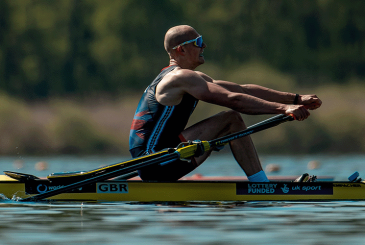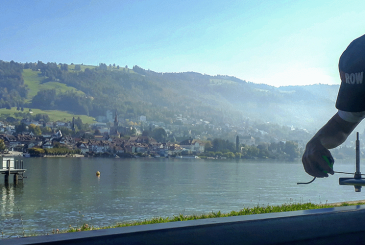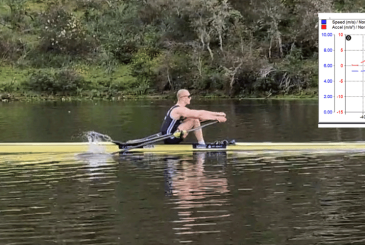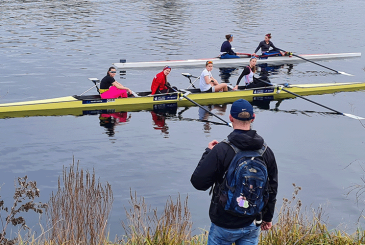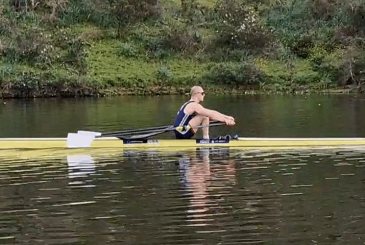Your club safety plan should include a risk assessment that sets out criteria for cancelling on-water activity, taking into account flow rates, wind speed/ direction, and local river hazards such as weirs. If you do go afloat on swollen rivers that have been deemed safe for rowing, particularly as floods are subsiding, make sure you’re aware of these tips.
Make sure you are familiar with RowSafe and other relevant guidance on our Safety page.
On-water Tip 1: Be aware that the water in flooded rivers tends to move quickly
High water levels lead to faster flows and the consequential dangers, including difficulties in boating, rowers being unable to make headway against the flow and losing control of the boat on the water.
On tidal waters, when the tide is ebbing (going out) then the flow speed is a combination of the tidal current and the fluvial flow. The fluvial flow is the flow of what was rainwater from the catchment area of the river. This is an additive effect, and the flow speed can be very high. When the tide is flooding (coming in) then the fluvial flow tends to counteract the tidal flow, and this results in the flow speed being reduced. This is a subtractive effect. For this reason, it is safer to row on the flood tide than it is on the ebb tide.
How to reduce likelihood of an incident:
- Start by rowing upstream.
- Use bigger, faster and more stable boats.
- Avoid the outside of bends as you may be swept further to the side and into an obstruction.
- Ensure the whole crew is ready to do firm pressure – and capable of responding promptly to the command – if necessary to counteract the stream pushing the boat towards an obstruction or hazard.
How to reduce the severity of harm if the crew gets into difficulty:
- Rescue the crew with a launch.
- Land the boat and carry it back to the boathouse.
On-water Tip 2: Be aware that the water in flooded rivers tends to be turbulent
Fast-moving water can lead to greater turbulence in the river, often just below the surface and invisible from the bank or boat. Turbulence can be a particular problem downstream of fixed objects in the water such as bridges, moored boats, navigation and mooring buoys, pontoons and floating docks, and weirs.
Turbulence will make steering and retaining control of boats challenging. Singles and pairs, in particular, can capsize if one blade gets caught in a vortex.
How to reduce likelihood of an incident:
- Avoid areas that can be turbulent.
How to reduce the severity of harm if the crew gets into difficulty:
- Rescue the crew with a launch or throw line from the bank.
On-water Tip 3: Take extra care to avoid stationary objects
You’ll obviously want to avoid colliding with stationary – or floating – objects at any time. Extra care ie needed during floods because you can be swept onto them faster if you stop. The turbulence (described above) from one stationary object can also push you onto another one nearby.
How to reduce likelihood of an incident:
- Take extra care to avoid obstructions and do not stop upstream of one.
- Have a coach to supervise the outing and provide an extra lookout for hard-to-see objects, which can include tree branches floating or stuck on the river bed.
How to reduce the severity of harm if the crew gets into difficulty:
- Rescue the crew with a launch or throw line from the bank.
On-water Tip 4. Beware solid objects below the water
It can be possible to row over flooded meadows or farmland where rivers have burst their banks. In deciding whether to do this, make sure you’re aware of fixed obstructions below the water such as fences, bushes, or benches that can cause dangers.
How to reduce likelihood of an incident:
- Take care and keep a good look out.
- Check the depth.
- Use local knowledge.
How to reduce the severity of harm if the crew gets into difficulty:
- Land the boat and carry it back to the boathouse.
On-water Tip 5. Beware contaminated water
Flood water can be contaminated with untreated sewage, farm animal waste and other materials. So make sure you clean everything thoroughly – including yourself as well as your equipment.
If the water is ingested or enters the body through uncovered cuts or grazes, it can cause illnesses such as gastric upsets or Weil’s Disease.
How to reduce likelihood of infection or illness:
- Avoid exposure to the water (e.g. don’t dip your hands in the water to wet your slides, for example – use water from your water bottle instead).
- Cover cuts, etc with water-proof dressings.
How to reduce the severity of harm:
- Wash your hands immediately after the outing.
- Shower as soon as possible.
- Seek medical advice if there are symptoms.
Safety Alerts related to flooding
British Rowing has issued the following official Safety Alerts. These contain recommendations of which that all rowers, coxes and coaches should be aware.
Alternatives to rowing on the water
If you decide that on-water activity should be cancelled you can:
- Find a land-based training alternative (check out these suggestions for What to do (with juniors) when you can’t get on the water).
- Take your boats to an alternative stretch of water (such as a canal) where the flow is slower.
Further actions
Additional general safety measures for rowing in strong stream conditions include having a suitable launch available on the water to rescue crews, appropriate first aid equipment and training, and potentially having helpers to throw lines from the bank.
This article draws on one by Jon Mcleod, first published in Rowing & Regatta magazine in November 2019



